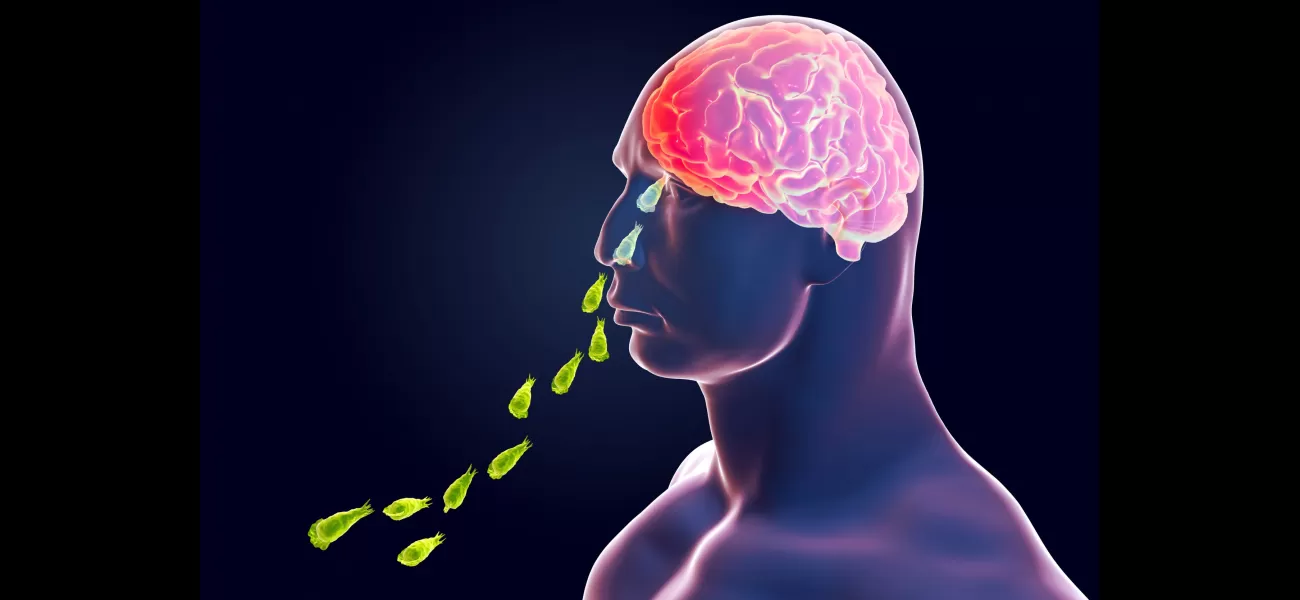25-year-old man dies from infection by fatal brain-eating amoeba.
The disease has a 97% chance of causing death.
July 9th 2024.

Sadly, another person has fallen victim to the rare and deadly 'brain-eating amoeba' in Israel. This is only the second time this infection has been seen in the country, making it a truly rare occurrence. The man, who has not been named, passed away after being infected with the amoeba known as naegleria fowleri. This single-celled organism has a menacing way of entering the brain through the nose, causing a fatal infection called primary amoebic meningoencephalitis. It's not hard to see why it's earned its terrifying name, as it literally feasts on a person's brain matter. Unfortunately, most people who contract this infection don't survive more than a week or two.
Experts have found that this amoeba thrives in warm temperatures and is commonly found in freshwater environments such as lakes, rivers, and hot springs. It can also be found in soil, making it a truly adaptable and dangerous microbe. In this case, the man was a healthy 25-year-old who is believed to have come into contact with the microbe while swimming at Gai Beach, Kinneret. He was admitted to the hospital after experiencing symptoms such as fever, headaches, and vomiting. Despite the best efforts of the medical team, he was unable to overcome the infection and sadly passed away on Sunday.
But what exactly is this 'brain-eating amoeba' and where can it be found? Well, let's just say it's as disturbing as it sounds. Naegleria fowleri is a highly lethal microbe that typically lurks in warm freshwater bodies such as ponds and lakes. It can also be found in hot springs and soil. However, it is not present in saltwater. In some cases, this amoeba has been found in neti pots, which are used to clear sinuses, and in water discharge from industrial plants.
Now, you may be wondering how one can catch this deadly infection. The primary way it enters the body is through the nose. Swimmers and divers are at the highest risk, as the water they are in can flush the amoeba into their nasal passages. However, it's important to note that you cannot get infected by touching contaminated water or by swallowing it. The infection also cannot be passed from one person to another.
So what exactly does this amoeba do once it enters the body? Well, it usually feeds on bacteria, but when it finds itself inside a human, it starts to feed on brain matter. It does this by moving up to the brain through the olfactory nerve. Once there, it begins to consume astrocytes and neurons, destroying brain tissue in the process.
The symptoms of this infection start about five days after exposure and can include headache, nausea, and vomiting. These early signs can easily be confused with meningitis, so it's crucial for people to inform their doctors if they have recently been swimming in freshwater. The infection progresses very quickly, and unfortunately, the majority of people who contract it pass away within a week or two. Treatment options are limited, with the most common being Amphotericin B and fluconazole. However, researchers have also found that miltefosine, an anti-cancer drug, and coating silver particles with anti-seizure drugs can effectively kill the organism.
To avoid being infected, experts recommend taking simple precautions such as holding your nose or using a nose clip while swimming in warm bodies of water. It's also important to avoid stirring up dirt or mud while underwater. In this case, Israeli health officials are currently investigating the man's death, but no trace of the amoeba has been found at Gai Beach. This is the second recorded case of PAM caused by naegleria fowleri in Israel, with the first being the death of a 36-year-old man in August 2022. Unfortunately, this infection has a 97% mortality rate, but it's important to remember that it is incredibly rare.
However, experts are concerned about the rising number of cases in the US, and some believe that climate change may be playing a role. Naegleria fowleri prefers warmer water temperatures, but it can survive colder temperatures by burying itself in sediment. As we continue to see changes in our climate, it's important to be aware of the potential risks and to take precautions when swimming in freshwater environments.
Experts have found that this amoeba thrives in warm temperatures and is commonly found in freshwater environments such as lakes, rivers, and hot springs. It can also be found in soil, making it a truly adaptable and dangerous microbe. In this case, the man was a healthy 25-year-old who is believed to have come into contact with the microbe while swimming at Gai Beach, Kinneret. He was admitted to the hospital after experiencing symptoms such as fever, headaches, and vomiting. Despite the best efforts of the medical team, he was unable to overcome the infection and sadly passed away on Sunday.
But what exactly is this 'brain-eating amoeba' and where can it be found? Well, let's just say it's as disturbing as it sounds. Naegleria fowleri is a highly lethal microbe that typically lurks in warm freshwater bodies such as ponds and lakes. It can also be found in hot springs and soil. However, it is not present in saltwater. In some cases, this amoeba has been found in neti pots, which are used to clear sinuses, and in water discharge from industrial plants.
Now, you may be wondering how one can catch this deadly infection. The primary way it enters the body is through the nose. Swimmers and divers are at the highest risk, as the water they are in can flush the amoeba into their nasal passages. However, it's important to note that you cannot get infected by touching contaminated water or by swallowing it. The infection also cannot be passed from one person to another.
So what exactly does this amoeba do once it enters the body? Well, it usually feeds on bacteria, but when it finds itself inside a human, it starts to feed on brain matter. It does this by moving up to the brain through the olfactory nerve. Once there, it begins to consume astrocytes and neurons, destroying brain tissue in the process.
The symptoms of this infection start about five days after exposure and can include headache, nausea, and vomiting. These early signs can easily be confused with meningitis, so it's crucial for people to inform their doctors if they have recently been swimming in freshwater. The infection progresses very quickly, and unfortunately, the majority of people who contract it pass away within a week or two. Treatment options are limited, with the most common being Amphotericin B and fluconazole. However, researchers have also found that miltefosine, an anti-cancer drug, and coating silver particles with anti-seizure drugs can effectively kill the organism.
To avoid being infected, experts recommend taking simple precautions such as holding your nose or using a nose clip while swimming in warm bodies of water. It's also important to avoid stirring up dirt or mud while underwater. In this case, Israeli health officials are currently investigating the man's death, but no trace of the amoeba has been found at Gai Beach. This is the second recorded case of PAM caused by naegleria fowleri in Israel, with the first being the death of a 36-year-old man in August 2022. Unfortunately, this infection has a 97% mortality rate, but it's important to remember that it is incredibly rare.
However, experts are concerned about the rising number of cases in the US, and some believe that climate change may be playing a role. Naegleria fowleri prefers warmer water temperatures, but it can survive colder temperatures by burying itself in sediment. As we continue to see changes in our climate, it's important to be aware of the potential risks and to take precautions when swimming in freshwater environments.
[This article has been trending online recently and has been generated with AI. Your feed is customized.]
[Generative AI is experimental.]
0
0
Submit Comment





